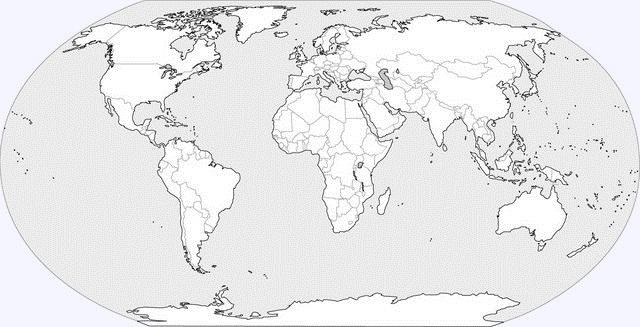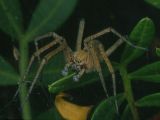|
Nombre común en ingles:
Nursery web spiders
/ Fish-eating spiders
Nombre común en castellano:
Se desconoce
Familias similares:
Género tipo:
Pisaura Simon, 1885
Diagnosis:
Medium-sized to very large
araneomorph spiders: three tarsal claws; ecribellate; entelegyne;
eight eyes some of which on shallow tubercles; abdomen elongated,
tapering towards back; tarsi with pseudosegment; trochanters deeply
notched. Egg-case carried in the chelicerae.
Caracteres descriptivos:
Caparazón:
longer than wide; clypeus in some genera with blunt tubercles on
anterolateral edge; clothed in plumose setae. Esternón:
longer than wide; apex blunt. Ojos: eight; in two (4:4),
three (4:2:2) or four (2:2:2:2) rows; at least one pair of eyes on
shallow tubercles; secondary eyes with grate-shaped tapetum. Quelíceros:
cheliceral furrow with teeth, number varies between genera. Piezas bucales:
labium longer than wide. Patas: three claws; legs relatively
long, sometimes slightly laterigrade; with setae on patellae,
femora, tibiae and metatarsi; tarsi with trichobothria in two rows,
or scattered; trochanters deeply notched; tarsi with pseudosegment;
unpaired claws with 2-3 teeth. Palpo femenino:
tarsus long with well developed toothed claw. Abdomen:
elongated, tapering towards back, rarely oval; usually with plumose
setae. Hileras:
anterior and posterior spinnerets similar in size. Sistema respiratorio:
two booklungs; tracheal spiracle close to spinnerets. Genitalia:
entelegyne; epigyne consists of two integumental folds, forming two
lateral elevations with a median area; internal structure complex,
consisting of a base with enlarged lumen and a stalk leading to
spermathecae; male palp with tibial apophysis usually present;
cymbium usually elongated anteriorly; bulbus oval, longitudinal axis
frequently inclined; median apophysis present, often with several
extra tegular appendages; embolus varies from simple and short to
long and curved. Tamaño corporal:
8-30 mm. Color: cryptic; carapace frequently decorated with
white longitudinal bands or symmetrical patterns of black on a brown
or grey background; abdomen with longitudinal bands, folium or
spots.
Estatus taxonómico:
Griswold (1991) found that the Lycosidae, Trechaleidae and
Pisauridae form a monophyletic group in the Lycosoidea.
Distribución: mundial.

Estilo de vida: Pisaurids
are either free-living or web-bound. The web is a sheet with a large
funnel often leading into the ground. They occupy various habitats
and are found on the ground, on plants or in association with water.
The egg-case is carried in the chelicerae underneath the stenum.
Females construct a nursery web to accommodate the spiderlings.
Bibliografía:
-
Carico, J.E. 2005a.
Pisauridae, pp. 199-200 in Ubick, D., Paquin, P., Cushing, P.E. &
Roth, V. (Eds) 2005. The Spiders of North America. An Identification
Manual. American Arachnological Society.
-
Dippenaar-Schoeman, A.S. & Jocqué,
R. 1997. African Spiders: An Identification Manual. Plant Protection
Res. Inst. Handbook, no. 9, Pretoria, 392 pp.
-
Jocqué, R. 1994.
Halidae, a new spider family from Madagascar (Araneae). Bull. Br.
arachnol. Soc. 9: 281-289.
-
Sierwald, P. 1989.
Morphology and ontogeny of female copulatory organs in American
Pisauridae, with special reference to homologous features (Arachnida:
Araneae). Smithson. Contrib. Zool. 484: 1-24.
-
Sierwald, P. 1990.
Morphology and homologous features in the male palpal organ in
Pisauridae and other spider families, with notes on the taxonomy of
Pisauridae (Arachnida: Araneae). Nemouria 35: 1-59.
-
Sierwald, P. 1993.
Revision of the spider genus Paradossenus, with notes on the family
Trechaleidae and the subfamily Rhoicininae (Araneae, Lycosoidea).
Revue arachnol. 10: 53-74.
-
Sierwald, P. 1997.
Phylogenetic analysis of pisaurine nursery web spiders, with
revisions of Tetragonophthalma and Perenethis (Araneae, Lycosoidea,
Pisauridae). J. Arachnol. 25: 361-407.
2 géneros y 2 especies presentes en la Península Ibérica:
|
| |
- D. fimbriatus
(Clerck, 1757) |
|
| |
- P. mirabilis
(Clerck, 1757) |
| |
|
 |